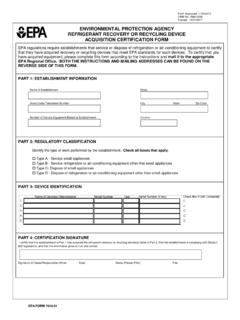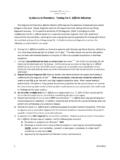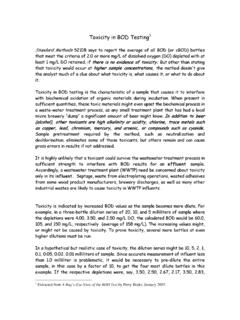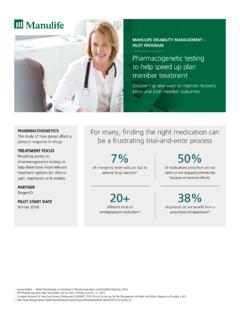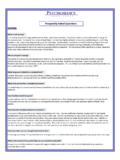Transcription of EPA Home Water Testing Facts
1 H o m e W a t e r T e s t i n gRegardless of your Water source, here are two situations that may require Testing :Do you suspect lead may be in some of your household plumbing materials and Water service lines? Most Water systems test for lead as a regular part of Water monitoring. These tests give a system-wide picture, but do not refl ect conditions at a specifi c household you want to know if your home s drinking Water contains unsafe levels of lead, have your Water tested. Testing is the only way to confi rm if lead is present or faucet and pitcher fi lters can remove lead from drinking Water .
2 If you use a fi lter to remove lead, be sure you get one that is certifi ed to remove lead by NSF International. For more information, visit , or call the Safe Drinking Water Hotline at you considering a home Water treatment unit?Find out what is in your Water and what you might want to remove before contacting potential dealers. Be informed so you can make the right decisions. To help you, please visit: #hwtu and I Have My Water Tested? The answer to this question depends on several factors. It concerns your health and the health of your family, so you need to know some basic Facts .
3 In addition to illness, a variety of less serious problems such as taste, color, odor and staining of clothes or fi xtures are signs of possible Water quality problems. Other things to think about include the nearness of your Water well to septic systems and the composition of your home s plumbing materials. This fact sheet provides information to help you decide whether or not to have your Water tested, and if so, suggested tests for your Water SystemsWhen you turn on the tap, where does the Water come from? If you pay a Water bill, you are purchasing Water from a public Water system, where your Water is monitored, tested and the results reported to the federal, state or tribal drinking Water agencies responsible for making sure it meets the National Primary Drinking Water Standards.
4 Your Water company must notify you when contaminants are in the Water they provide that may cause illness or other problems. Most people in the United States receive Water from a community Water system that provides its customers with an annual Water quality report, also known as a Consumer Confi dence Report. Normally, you will receive it with your Water bill once a year in July. The report contains information on contaminants found, possible health effects, and the Water s source. If you do not receive a report, contact your Water company for this information.
5 Private Water SuppliesIf your drinking Water does not come from a public Water system, or you get your drinking Water from a household well, you alone are responsible for assuring that it is safe. For this reason, routine Testing for a few of the most common contaminants is highly recommended. Even if you currently have a safe, pure Water supply, regular Testing can be valuable because it establishes a record of Water quality. This record is helpful in solving any future problems and in obtaining compensation if someone damages your Water supply.
6 The following items will help you determine when to test your private drinking Water frequently should I test?Test Water every year for total coliform bacteria, nitrates, total dissolved solids and pH levels, especially if you have a new well, or have replaced or repaired pipes, pumps or the well casing. Do you expect to have a new baby in the household? Test for nitrate in the early months of a pregnancy, before bringing an infant home , and again during the fi rst six months of the baby s life. It is best to test for nitrate during the spring or summer following a rainy period.
7 Do you have taste, odor and staining issues? Test for sulfate, chloride, iron, manganese, hardness and corrosion, and every three years. If you suspect other contaminants, test for these also. Have you had a chemical or fuel spill or leak near your Water supply? Test your well for chemical contaminants, such as volatile organic compounds. Tests can be expensive; limit them to possible problems specifi c to your situation. Local experts can tell you about possible impurities in your someone in your household pregnant or nursing an infant?
8 Are there unexplained illnesses in your family? Do you notice a change in Water taste, odor, color or clarity? You may need to test more than once a you know who can test your Water ? Often county health departments will help you test for bacteria or nitrates. If not, you can have your Water tested by a state certifi ed laboratory. You can fi nd one in your area by calling the Safe Drinking Water Hotline at 800-426-4791 or visiting SamplesMost Testing laboratories or services supply their own sample containers. Use the containers provided and carefully follow the instructions given for collecting, preserving and handling Water samples.
9 Samples for coliform bacteria Testing must be collected using sterile containers and under sterile conditions. Some procedures require that Water runs from an outside tap for several minutes before fi lling the sample containers. Laboratories may sometimes send a trained technician to collect the sample or to analyze the sample directly in your home . Ask if this service is available, since you may obtain better samples and more reliable test ce of Water (4606) EPA 816-F-05-013 May 2005 WHEN TO TEST YOUR WATERC onditions or nearby activitiesRecommended TestRecurrent gastro-intestinal illnessColiform bacteriaHousehold plumbingcontains leadpH, lead, copperRadon in indoor air or region is radon richRadonScaly residues, soaps don t latherHardnessWater softener needed to treat hardnessManganese, ironStained plumbing fi xtures, laundryiron, copper, manganeseObjectionable taste or smellHydrogen sulfi de, corrosion.
10 MetalsWater appears cloudy, frothy or coloredColor, detergentsCorrosion of pipes, plumbingCorrosion, pH, leadRapid wear of Water treatment equipmentpH, corrosionNearby areas of intensive agricultureNitrate, pesticides, coliform bacteriaCoal or other mining operation nearbyMetals, pH, corrosionGas drilling operation nearbyChloride, sodium, barium, strontiumOdor of gasoline or fuel oil, and near gas station or buried fuel tanksVolatile organic compounds (VOC)Dump, junkyard, landfi ll, factory or dry-cleaning operation nearbyVOC, Total disolved solids (TDS), pH, sulfate, chloride, metalsSalty taste and seawater, or a heavily salted roadway nearbyChloride, TDS, sodium









